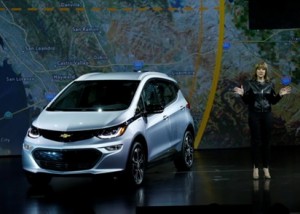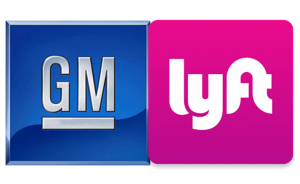Last November, we ran a post about how the big automakers were moving at light speed to embrace disruptive concepts, from autonomous driving and shared mobility. And the trend continued at CES last week. Everywhere we went, self-driving cars and new transportation platforms were being debated, discussed, and displayed.
General Motors announced a partnership with Lyft, the #2 (and rising) transportation service. In Las Vegas, Lyft was giving away five free rides, and you can bet that many of the 170,000 attendees (including me) took them on this deal. GM’s Chairman and CEO explained to Vanity Fair that there’s more to this deal than just business:
“My senior leadership team is half people who have been at GM for a long period of time like me, and others who have joined the company within the last five years from different industries, experiences, and countries. You have a better picture of the world. The diversity of thought is where you can make better business decisions.”
She also noted that Lyft’s executive team is especially diverse, including strong female inclusion – a rarity in Silicon Valley. Barra’s own rise at GM was due to a progressive attitude about building a pathway for females in the executive wing of her Detroit-based company.

She also announced their newest entry into the electrified vehicle market – the new Chevy Bolt EV. This new plug-in car features a 200 mile range for under $30,000 (after federal tax credit). While Tesla has been making noise in the electric car market, Chevy fully intends to be a player in this space.
And not to be outdone, Ford continues to look at shared mobility as an opportunity – not a threat. On the surface, services like Uber and Zipcar are highly attractive to the largest generation alive – Millennials. As more and more twentysomethings eschew the idea of car ownership, you’d think the auto companies would be somewhere between panic and denial.
But the reality is that they see these changing trends and they want to not only be there – they want to lead the way. A deal between an automaker and a company trying to disrupt it may have been unthinkable just a few short years ago. Today, it is becoming a smart way of doing business.
That’s the new paradigm for market leaders and legacy companies. Mark Zuckerberg has become famous for buying businesses that complement the Facebook core. As social photo sharing emerged as a major trend, he simply bought Instagram. On the messaging side, he sucked up WhatsApp.
It seems like every modern-day CEO remembers what happened when Kodak went into denial about digital photography. No one can afford to make that mistake in this fast-moving environment, especially when it involves the lifestyles and cultures of Millennials.
And Ford’s next step is an app that will make headlines, unveiled at the North American International Auto Show in Detroit. As CEO Mark Fields continues to remind audiences, Ford is “a mobility company and an auto company.” Mashable says that FordPass contains a number of features, including FlightCar.
Fields talked about this at last year’s CES. The service enables Ford owners to share or borrow a vehicle while traveling. Ultimately, the idea is to turn this into a ride sharing service using any number of transportation modes, from cars to light rail to even bicycles.
So why would an automaker embrace a disruptive technology like shared mobility?
Because the way you remain relevant and profitable in this technological environment is to do your research, and then place smart bets on the gadgets, devices, platforms, and concepts that have the best chance of delivering on the promise.
At CES last week, we saw a number of new technologies that may have resonance in the world of radio broadcasting – soon and in the not-too-distant future. From virtual reality to 3D printers to devices that talk to each other, there’s a plethora of innovative gadgets that created buzz throughout Las Vegas.
Notably, some of the biggest companies are doing some amazing things with these tools. But behind many of their efforts is an increasing openness to disrupting their core brands, even though it may come with some risk.
 In retrospect, it might have seemed impetuous and rash for a broadcaster to have bought XM Radio in the late ‘90s. Or even Pandora when it was struggling just a few short years ago. Instead of pointing fingers at the disruptors, and attempting to marginalize their impact, imagine partnering with them, investing in them, purchasing them, and learning from them as a new way for radio to move forward.
In retrospect, it might have seemed impetuous and rash for a broadcaster to have bought XM Radio in the late ‘90s. Or even Pandora when it was struggling just a few short years ago. Instead of pointing fingers at the disruptors, and attempting to marginalize their impact, imagine partnering with them, investing in them, purchasing them, and learning from them as a new way for radio to move forward.
That’s part of what we’re seeing as radio companies utilize Shazam’s technology, or partner with potential disruptors like Midroll, Podcast One, and others.
One of the key lessons of the Internet age that it may be better to embrace the changes – even the ones that might appear to hurt the mother ship – rather than face serious turbulence from these outside attackers once they scale and build up their brands. That’s what we saw last week at CES.
While it would have seemed outrageous to have seen Pandora or SiriusXM logos proudly displayed at last year’s Radio Show in Atlanta, the expectation is that we will see Lyft, co-branded with GM at the next CES, just as we are witnessing the automakers embrace Apple and Google via CarPlay and Android Auto, even though there is abundant risk in partnering with these tech behemoths. (More on those two platforms and what they will mean to the radio broadcasting industries in tomorrow’s post.)
As a very wise man once said, “Turn and face the strange ch-ch-changes.”
In partnership with Inside Radio, we’re presenting a free webinar on Wednesday, January 27 at 2pm ET, “10 Innovations From CES 2016 & What They Mean To Radio.” You can register here.
- Media In 2025: Believe It Or Not! - January 15, 2025
- Every Company Is A Tech Company - January 14, 2025
- The Changing Face Of Social Media (OR WTZ?!) - January 13, 2025





Leave a Reply